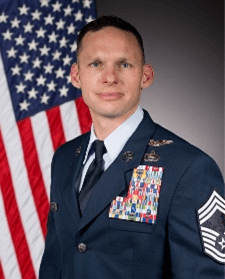The Defense Ventures Fellows program is an immersion program for active-duty military service members, who spend 2 weeks in a cohort-based training, and then 6 weeks embedded in a venture capital firm or portfolio company -- after which they return to the military with new insights about the innovation economy.
Here at Insight Partners, we hosted two Airmen, Chief Master Sergeant Ian Eishen (from the Strategic Studies Group in the Pentagon) and Major Richard Barnes (from DIU in Silicon Valley).
As they return to the Air Force full time, I asked Ian and Richard a few questions about their experience and to reflect on their time at Insight.
What did you learn from your experience as a Defense Ventures Fellow at Insight Partners?
Ian: I learned that relationships are your most valuable resource. In just six weeks, we were able to make meaningful relationships across the Defense Ventures cohort, the team at Insight, and the many portfolio companies. These relationships will become even more important as we all move forward and attempt to solve our nation’s toughest challenges.
Richard: I was impressed with the professionalism, experience, and enthusiasm across Insight. I was also pleasantly surprised by the depth of diligence that is performed to assess risk in an investment.
What was your biggest surprise?
Ian: I think my biggest surprise happened in the first week, as I watched analysts fresh out of college speak to entrepreneurs on behalf of a multi-billion-dollar VC. The amount of trust Insight places into each of its employees is impressive and reminds me of the level of trust the military places in an 18-year-old fresh out of basic training. Both organizations are successful because of the amazing talent they onboard to the team and the professionals that dedicate their time to up-skilling and developing that talent.
Richard: My biggest surprise was how much trust Insight puts its investment team members to make judgments about where to focus. It was impressive to see the responsibility that Insight gives investment team members, especially when researching and sourcing potential investments.
What advice do you have for venture-backed companies who want to work with the Air Force?
Ian: My first recommendation is to try and understand DoD “colors of money” and acquisitions authorities. My second recommendation is to take time to focus on the actual problem the DoD is trying to solve. Often, the problem that is presented is simply a symptom of a different problem upstream and if the root problem is not addressed, we will all find ourselves trying to implement the wrong solution.
Richard: My recommendation is for companies to understand processes and don’t be discouraged. If the product is useful for the mission, there will be champions, funding, and ways to get it into the system. Together, we can work through the challenges.
What are you going to take back to the Air Force? What do you think the Air Force should be doing differently?
Ian: I have an entire book full of notes to take with me back to the Air Force, but one observation is that Insight invests in amazing technical talent. This talent, at both the firm and portfolio company level, can take advantage of best-in-class technology and evolve them as their needs change. This shift is not as easy in the military so I would like to help the Air Force build processes that can more easily adapt to external variables and technological advances.
Richard: Through my time at DIU, I have always believed alternative means of acquisition should be both advertised and scoped more effectively to bring in commercial companies. The organizations that support these avenues are still handcuffed in various ways that limit the ability to take advantage. The pace at which commercial entities can iterate and advance capabilities needs to be available to the entire DoD.
Ian, you have experience with USAF’s AI efforts, and currently, work in the think tank (strategic studies group) for the Chief of Staff of the Air Force. From those vantage points, and your recent Insight experience, what has been your impression of commercial AI companies, and their ability to serve the mission?
Ian: The artificial intelligence landscape is always changing and so I am constantly impressed when companies can take a new idea and quickly use it to solve a problem in the world. Talented founders and teams mean that the cycle time between ideation and solution is rapidly decreasing, and we need to take advantage of that so our nation can maintain its competitive advantage.
Richard, you have great field experience as a pararescue jumper, combined with your experience at DIU managing a human systems program – how should VCs be thinking about technologies designed for the field?
Richard: DoD organizations develop and advertise requirements in many ways. Sometimes, a company will look at a requirement and conclude that its products don’t quite meet that requirement. My advice is to always look at the whole picture. Even if you can’t provide the entire solution, there may we places where you can insert your technology, begin to build real relationships, and iterate with the defense customer.
How can venture-backed companies figure out what problems the DoD is trying to solve?
Ian: The DoD signals its problems in a variety of ways but there isn’t an easy-to-read website or article titled “Here is where we need help”. Instead, you must read through a variety of sources including the budget, science, and technology strategies, focus areas for the national laboratories, and speeches at military conferences. The signals are always out there, but sometimes, you must read through the tea leaves. In DoD, we need to keep working to make it easier for companies to understand our needs.

Chief Master Sergeant Ian D. Eishen is the Senior Enlisted Leader for the CSAF Strategic Studies Group at the Pentagon and has spent twenty-one years and eight deployments in the special operations and intelligence communities. He advises the Air Staff in a diverse portfolio including artificial intelligence, quantum, disruptive technologies, and talent management. Ian manages many initiatives focused on developing next generation Airmen, digital transformation and developing business relationships with coalition and joint partners, academia, the tech industry, and the intelligence community. Since 2017, he has worked with Hacking4Defense, a DoD sponsored university course that instructs students to address emerging threats and security challenges in the Defense and Intelligence Communities. His work with Stanford University, the U.S. Air Force Academy and the University of Virginia has spurred multiple solutions that have been scaled in the U.S. Air Force and Navy. Ian has also launched many products and prototypes focused on combating suicidal ideation including a graphic novel anthology titled “True War Stories” in which veterans address trauma through storytelling.

Major Richard Barnes is a Combat Rescue Officer in the Air Force serving as a program manager at the Defense Innovation Unit in Mountain View, CA working in the Human Systems Portfolio where he helps bring commercial solutions to support the Department of Defense (DoD) mission. This is done primarily utilizing Other Transaction Authorities, providing both DoD partners and vendors greater opportunity to solve problems in a more collaborative and expedited fashion. He graduated from George Fox University and holds a Masters Degree through Air University. Major Barnes began his enlisted career as a Pararescueman and was commissioned through the Air Force Officer Training School. Assignments include Combat Search and Rescue squadrons; United States Air Force (USAF) Survival School support in WA, AL and FL; Joint Commands in NC and Germany; as well as multiple joint and multinational deployments.









